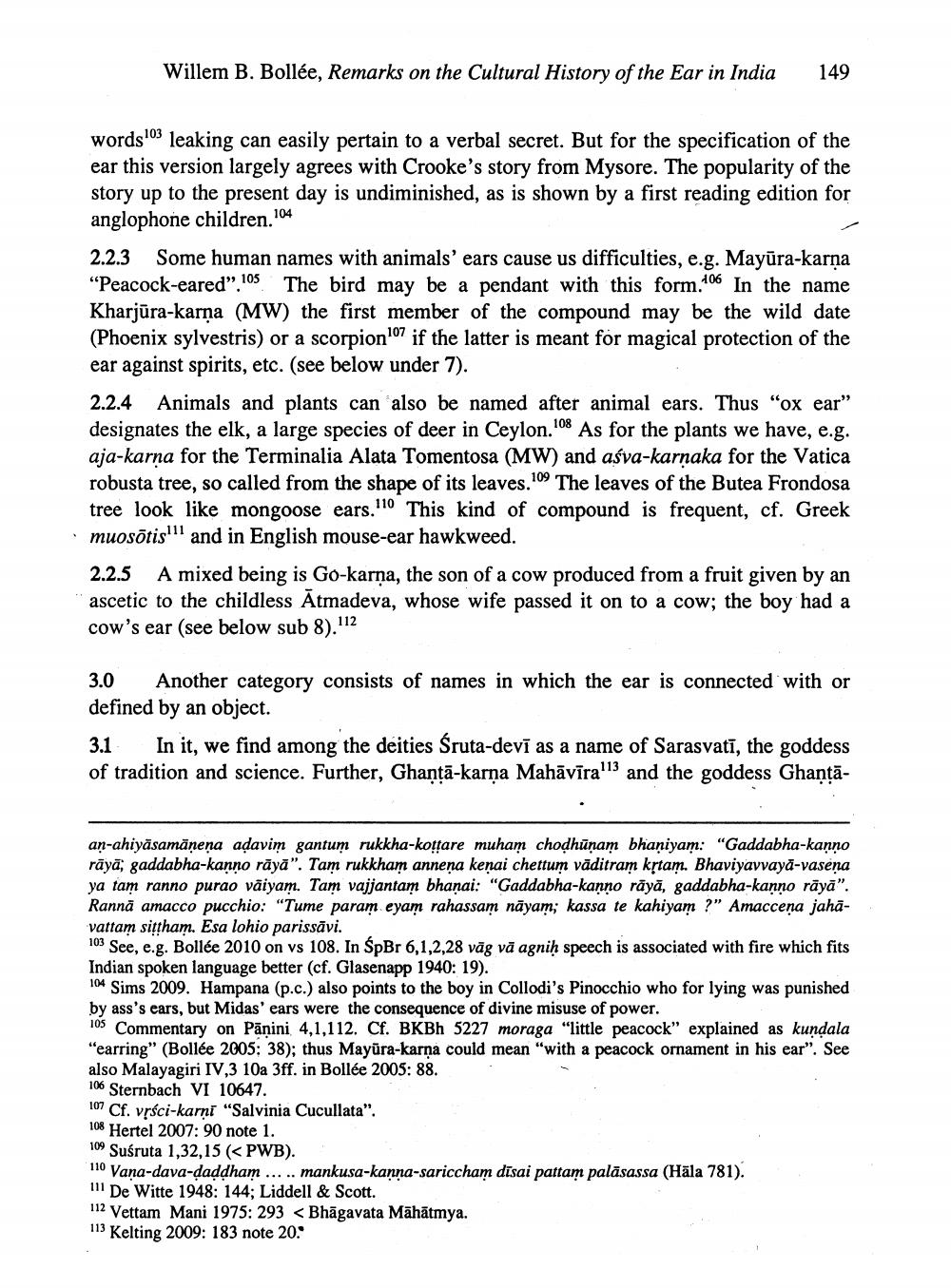________________
Willem B. Bollée, Remarks on the Cultural History of the Ear in India
149
words leaking can easily pertain to a verbal secret. But for the specification of the ear this version largely agrees with Crooke's story from Mysore. The popularity of the story up to the present day is undiminished, as is shown by a first reading edition for anglophone children. 104 2.2.3 Some human names with animals' ears cause us difficulties, e.g. Mayūra-karna "Peacock-eared”. 105 The bird may be a pendant with this form.106 In the name Kharjūra-karna (MW) the first member of the compound may be the wild date (Phoenix sylvestris) or a scorpion 107 if the latter is meant for magical protection of the ear against spirits, etc. (see below under 7). 2.2.4 Animals and plants can also be named after animal ears. Thus "ox ear" designates the elk, a large species of deer in Ceylon.108 As for the plants we have, e.g. aja-karna for the Terminalia Alata Tomentosa (MW) and asva-karnaka for the Vatica robusta tree, so called from the shape of its leaves. 109 The leaves of the Butea Frondosa tree look like mongoose ears.'10 This kind of compound is frequent, cf. Greek muosotis" and in English mouse-ear hawkweed. 2.2.5 A mixed being is Go-karņa, the son of a cow produced from a fruit given by an ascetic to the childless Ātmadeva, whose wife passed it on to a cow; the boy had a cow's ear (see below sub 8).112
3.0 Another category consists of names in which the ear is connected with or defined by an object. 3.1 In it, we find among the deities Śruta-devī as a name of Sarasvatī, the goddess of tradition and science. Further, Ghantā-karna Mahāvīra'13 and the goddess Ghantā
an-ahiyāsamānena adavim gantum rukkha-kottare muham chodhūnam bhaniyam: "Gaddabha-kanno rāyā, gaddabha-kanno rāyā". Tam rukkham annena kenai chettum vāditram krtam. Bhaviyavvayā-vaseña ya tam ranno purao văiyam. Tam vajjantam bhanai: "Gaddabha-kanno rāyā, gaddabha-kanno rāyā". Rannā amacco pucchio: "Tume param eyam rahassam nāyam; kassa te kahiyam ?" Amaccena jahavattam sittham. Esa lohio parissāvi. 103 See, e.g. Bollée 2010 on vs 108. In SpBr 6,1,2,28 vāg vā agnih speech is associated with fire which fits Indian spoken language better (cf. Glasenapp 1940: 19). 104 Sims 2009. Hampana (p.c.) also points to the boy in Collodi's Pinocchio who for lying was punished by ass's ears, but Midas' ears were the consequence of divine misuse of power. 105 Commentary on Pāṇini 4,1,112. Cf. BKBh 5227 moraga "little peacock” explained as kundala "earring" (Bollée 2005: 38); thus Mayūra-karņa could mean "with a peacock ornament in his ear". See also Malayagiri IV,3 10a 3ff. in Bollée 2005: 88. 106 Sternbach VI 10647. 107 Cf. vrści-karni "Salvinia Cucullata". 108 Hertel 2007: 90 note 1. 109 Suśruta 1,32,15 (< PWB). 110 Vana-dava-daddham ... .. mankusa-kanna-sariccham dīsai pattam palāsassa (Hāla 781). Il De Witte 1948: 144; Liddell & Scott. 112 Vettam Mani 1975: 293 < Bhāgavata Māhātmya. 113 Kelting 2009: 183 note 20.




